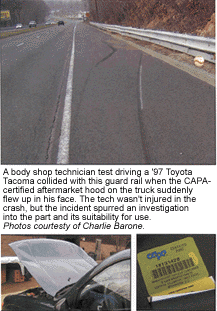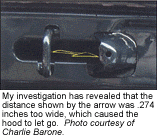 What spurred this rhetorical question is the most recent incident in which a CAPA-certified aftermarket replacement hood on a Toyota Tacoma opened unexpectedly when a technician took it for a test drive. What preliminary investigations have determined is that the secondary striker on the hood contained a nonconformity.
What spurred this rhetorical question is the most recent incident in which a CAPA-certified aftermarket replacement hood on a Toyota Tacoma opened unexpectedly when a technician took it for a test drive. What preliminary investigations have determined is that the secondary striker on the hood contained a nonconformity.
Basically, it doesn’t work. And not just this one. Word is that none of the hoods like this made by Jui Li and its manufacturing partners in Taiwan are fit for duty.
Despite a recent acknowledgment by the manufacturer’s U.S. importer that the nonconformity in the hoods’ strikers exists and a recall by a U.S. distributor, there’s been no rush to judgment by CAPA. They did, however, decertify the part, albeit reluctantly.
Some of you will recall the cover story of the February 1999 issue of “Consumer Reports” that featured another hood that flew up in the face of a Honda Accord owner. That also was a CAPA-certified part with a major nonconformity that caused it and others like it to fly in the face of its owners. That hood, however, has faded into memory, having been dismissed by the association as a hoax. So it’s back to the business of rubber-stamping bootleg parts.
This incident has CAPA taking cover again. Their first response was to deny it was one of theirs, despite the Jui Li, API and Ensure hoods being in their public database, not to mention displaying the yellow badges in distributor inventories and on who-knows-how-many Toyota Tacomas. Apparently someone scraped the CAPA sticker off the inside of this particular part before it was painted.
Says CAPA spokesperson Stephanie Ackerman: “We know of no reason why a repair shop would have a need to remove the CAPA seal. Doing so would only eliminate their ability to prove the use of a CAPA part or trace the part if necessary. If a repairer, distributor, consumer or insurer removes a seal from a part, then they’re effectively voiding the certification of that part.”
I think this could be a case of Ackerman smoking her own press releases. What Ackerman may not understand is that there aren’t a whole lot of body shop owners who’d want a CAPA part traced to them. Let’s have a quick poll: All those shop owners reading this whose technicians proudly leave CAPA stickers on the non-OEM hoods they install, raise their hands.
I rest my case.
What’s of more concern than their out-of-touch-with-reality attitude is that by right of the mere de-certification of this hood, CAPA thinks they can simply walk away from this part. But their responsibility in this goes a great deal deeper, I’m afraid.
If CAPA is what they purport to be, then it could be argued that body shops, insurance companies and distributors have formed a reliance on the CAPA certification. Ostensibly, the CAPA part is a cut above – one that’s safe to use and presumed to be the functional equivalent to the OEM part. This presumption, as we know, is dubious, but is significant in the fact that people depend on a validating organization like CAPA to actually do something when certifying these parts, outside of selling their makers little yellow seals. You expect that a person would at least have done what I did and put a dial caliper on the striker and measured it against the OEM part.
CAPA has now dropped their certified hood in the hands of NHTSA and once their investigation is completed, they’ll have apparently washed their hands of the matter.
Not so fast. One could argue that but for the CAPA certification, many distributors and end users might never have installed this hood on a Tacoma, so whose responsibility is it? The shops? Those insurance companies enriched in the substitution? Or should the validator play some part in retrieving these oversized box cutters before someone gets seriously hurt?
Apparently, the insurance industry has had varying reactions to the possibility of another one of these hoods causing a world of hurt to them. A few companies have notified their DRP shops and claims offices not to use this hood. Others have adopted a see-what-happens attitude and are content to wait for the results of the CAPA investigation.
Rod Enlow, chairman of CAPA’s Technical Committee was quick to respond to what he sees as a rush to judgment. “This is only one hood,” he says. Enlow also dipped into the aftermarket parts industry bag of phrases and insisted that “safety is not a factor of cosmetic sheet metal [body] parts.”
Oh really?

Enlow said that instead of being stampeded by an isolated incident of one hood flying open, he would urge the industry to abide the results of the CAPA study being done presently by their Entela Laboratories in Grand Rapids, Mich. This is the same group who had a hand in certifying this hood in the first place and all the rest of the CAPA’s best, lest we forget.
I would submit that this isn’t a case of “only one hood.” Apparently the dies that position the secondary striker during its manufacture were slightly off, leaving the nose of the striker too far from the latch’s hook on the OEM assembly. This means that the hood will hold on its primary striker, but the moment one isn’t fastened securely (how often does that happen?), it’ll let go like the one we saw in New Jersey. Therefore, this isn’t just one hood, but all hoods made by this plant in Taiwan. In fact, the importer for Jui Li actually saw the hood in question and confirmed this fact. What’s more, the distributor that sold this hood agreed and issued an immediate recall on all the hoods of this type he sold this year, which, in my opinion, was the right thing to do (quick and decisive action).
Quick and decisive, however, aren’t terms found in CAPA literature. They favor slow and deliberate, which is fine in pharmaceutical trials but not what we look for in the face of impending disaster, such as a hood flying open at speed. This isn’t the slow corrosion that works its way around the hem flanges of the typical aftermarket hood. It’s a consequence that occurs only when the truck is moving fast. But hey, call me an alarmist.
One more thing: There’s something disturbing about the fact that CAPA is investigating themselves. Any conclusion of their study that would confirm the nonconformity in this hood exists would prove their certification was bogus in the first place. The easy solution is to A. Claim this is a result of a conspiracy and another well-executed hoax, B. Simply de-certify the part and leave it to the federal government, or C. Stop answering the phone and send the staff on a badly needed vacation.
If I were Jack Gillis, CAPA executive director, I’d pick C and board the next chopper, evacuating their Washington office. Having blown yet another opportunity for CAPA to prove its efficacy in the industry, his choices in this matter are limited. CAPA could’ve stepped up to this the moment they were notified. Instead, they went on the defensive immediately and only de-certified the part after the manufacturer recalled the hood.
I see wanton disregard for safety on the part of CAPA, its underwriters and anyone satisfied to sit back and let the system fly the plane. Can anyone be so reckless as to believe that the mere act of decertifying this hood will prevent another hood from flying open? This accident in New Jersey was caused by a system in which these events are viewed like collateral damage. But we’re not at war with our customers, nor should their insurance companies be sending them off like so many unsuspecting crash test dummies in cars rebuilt with questionable parts.
The sight of those skid marks in New Jersey where the blinded driver hit the guardrail was enough to convince me that it wasn’t just a hood that failed, but the failure of an entire system. The aftermarket parts advocates say competition is good. The same applies to CAPA and their tenuous hold on the certification business.
Writer Charlie Barone has been working in and around the body shop business for the last 27 years, having owned and managed several collision repair shops. He’s an ASE Master Certified technician, a licensed damage appraiser and has been writing technical, management and opinion pieces since 1993. Barone can be reached via e-mail at [email protected]













